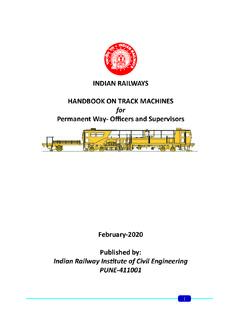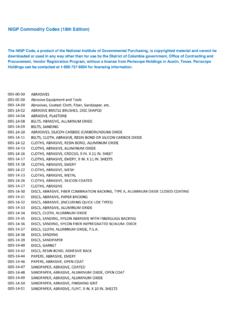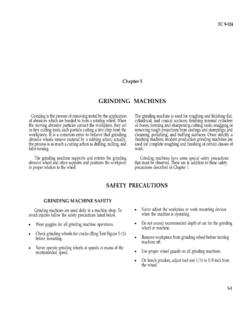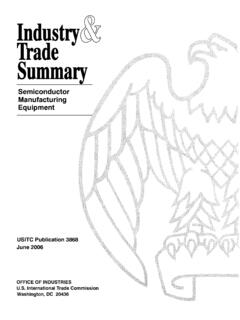Transcription of AP-42 9.9.1 Grain Elevators And Processes
1 4/03 Food And Agricultural Grain Elevators And Process Description1-14 Grain Elevators are facilities at which grains are received, stored, and then distributed for directuse, process manufacturing, or export. They can be classified as either country or terminal Elevators ,with terminal Elevators further categorized as inland or export types. Operations other than storage, suchas cleaning, drying, and blending, often are performed at Elevators . The principal grains and oilseedshandled include wheat, corn, oats, rice, soybeans, and Elevators are generally smaller Elevators that receive Grain by truck directly from farmsduring the harvest season.
2 These Elevators sometimes clean or dry Grain before it is transported toterminal Elevators or processors. Terminal Elevators dry, clean, blend, and store Grain before shipment toother terminals or processors, or for export. These Elevators may receive Grain by truck, rail, or barge,and generally have greater Grain handling and storage capacities than do country Elevators . Exportelevators are terminal Elevators that load Grain primarily onto ships for of whether the elevator is a country or terminal, there are two basic types of elevatordesign: traditional and modern. Traditional Grain Elevators are typically designed so the majority of thegrain handling equipment ( , conveyors, legs, scales, cleaners) are located inside a building orstructure, normally referred to as a headhouse.
3 The traditional elevator often employs belt conveyorswith a movable tripper to transfer the Grain to storage in concrete or steel silos. The belt and trippercombination is located above the silos in an enclosed structure called the gallery or bin deck. Grain isoften transported from storage using belt conveyors located in an enclosed tunnel beneath the silos. Particulate emissions inside the elevator structure may be controlled using equipment such as cyclones,fabric filters, dust covers, or belt wipers; Grain may be oil treated to reduce emissions. Controls are oftenused at unloading and loading areas and may include cyclones, fabric filters, baffles in unloading pits,choke unloading, and use of deadboxes or specially designed spouts for Grain loading.
4 The operations oftraditional Elevators are described in more detail in Section Traditional elevator design isgenerally associated with facilities built prior to and terminal Elevators built in recent years have moved away from the design of thetraditional Elevators . The basic operations performed at the Elevators are the same; only the elevatordesign has changed. Most modern Elevators have eliminated the enclosed headhouse and gallery (bindecks). They employ a more open structural design, which includes locating some equipment such aslegs, conveyors, cleaners, and scales, outside of an enclosed structure. In some cases, cleaners andscreens may be located in separate buildings.
5 The Grain is moved from the unloading area using enclosedbelt or drag conveyors and, if feasible, the movable tripper has been replaced with enclosed distributorsor turn-heads for direct spouting into storage bins and tanks. The modern Elevators are also moreautomated, make more use of computers, and are less labor-intensive. Some traditional Elevators havealso been partially retrofitted or redesigned to incorporate enclosed outside legs, conveyors, cleaners, andother equipment. Other techniques used to reduce emissions include deepening the trough of the open-belt conveyors and slowing the conveyor speed, and increasing the size of leg belt buckets and slowingleg velocity.
6 At loading and unloading areas of modern Elevators , the controls cited above for traditionalelevators can also be used to reduce first step at a Grain elevator is the unloading of the incoming truck, railcar, or barge. A truckor railcar discharges its Grain into a hopper, from which the Grain is conveyed to the main part of FACTORS4/03elevator. Barges are unloaded by a bucket elevator (either a continuous barge unloader or marine leg)that is extended down into the barge hold. The main building at an elevator, where Grain is elevated anddistributed, is called the headhouse . In the headhouse, Grain is lifted on one of the elevator legs and, atolder facilities, is typically discharged onto the gallery belt, which conveys the Grain to the storage bins.
7 A tripper diverts Grain off the belt and into the desired bin. At more modern facilities, other modes oftransfer include enclosed conveyors, direct spouting, augers, and screw conveyors. Grain is oftencleaned, dried, and cooled for storage. Once in storage, Grain may be transferred one or more times todifferent storage bins or may be emptied from a bin, treated or dried, and stored in the same or a differentbin. The most common method for unloading ships is by leg, using either an in-house leg operated by thefacility or a self-unloading system (leg and conveyors) designed into the vessel. Figure presentsthe major process operations at a Grain elevator.
8 A Grain processing plant or mill receives Grain from an elevator and performs variousmanufacturing steps that produce a finished food product. The Grain receiving and handling operations atprocessing plants and mills are basically the same as at Grain Elevators . Examples of processing plantsare flour mills, oat mills, rice mills, dry corn mills, and animal feed mills. The following subsectionsdescribe the processing of the principal grains. Additional information on Grain processing may be foundin AP-42 Section , Cereal Breakfast Food, and AP-42 Section , Corn Wet Milling. Flour Milling2,5 -Most flour mills produce wheat flour, but durum wheat and rye are also processed in flour mills.
9 The wheat flour milling process consists of 5 main steps: (1) Grain reception, preliminary cleaning, andstorage; (2) Grain cleaning; (3) tempering or conditioning; (4) milling the Grain into flour and itsbyproducts; and (5) storage and/or shipment of finished product. A simplified diagram of a typical flourmill is shown in Figure Wheat arrives at a mill and, after preliminary cleaning, is conveyed tostorage bins. As Grain is needed for milling, it is withdrawn and conveyed to the mill area where it firstenters a separator (a vibrating screen), then, an aspirator to remove dust and lighter impurities, and thenpasses over a magnetic separator to remove iron and steel particles.
10 From the magnetic separator, thewheat enters a disc separator designed to catch individual grains of wheat and reject larger or smallermaterial and then to a stoner for removal of stones, sand, flints, and balls of caked earth or mud. Thewheat then moves into a scourer which buffs each kernel and removes more dust and loose bran (hull orhusk). Following the scouring step, the Grain is sent to the tempering bins where water is added to raisethe moisture of the wheat to make it easier to grind. When the Grain reaches the proper moisture level, itis passed through an impact machine as a final cleaning step. The wheat flows into a grinding bin andthen into the mill Grain kernels are broken open in a system of breaks by sets of corrugated rolls, each settaking feed from the preceding one.














